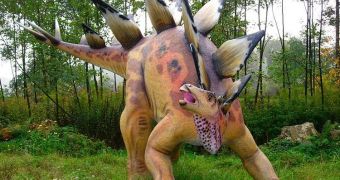For many years, paleontologists believed that the carcasses of pregnant ichthyosaur females were prone to exploding after death, due to the accumulation of putrefaction gases within their bodies. Now, new data appear to indicate that this was not the case.
The idea was first proposed so that scientists could explain why numerous, well-preserved ichthyosaur fossils were found surrounded by embryo bones, when the bodies of the mothers were intact. These weird bone arrangements puzzled researchers.
Ichthyosaurs are extinct marine reptiles that lived during the Mesozoic era, between 245 and 90 million years ago. During the Jurassic Period, they were the top predators in the ocean, before being replaced by plesiosaurs, during the Cretaceous Period.
The fossil that first surprised scientists in terms of bone arrangement was discovered near Holzmaden, in Germany. This individual, a female, was estimated to have lived around 182 million years ago.
Paleontologists say that the specimen is nearly perfect and very well preserved, with the majority of bones arranged in their anatomically correct positions. However, the fossil is surrounded by embryo bones, and experts had no plausible explanation for how they wound up outside the mother's body.
Ichthyosaur skeletons found during other excavations showed the same peculiarity, indicating that this was the norm, rather than the exception. The best explanation specialists could come up with was that the dinosaur carcasses exploded after death, due to accumulating putrefaction gases.
However, an elaborate series of measurements conducted on the fossils, doubled by physical and biological analyses of the animals themselves, demonstrated that the carcasses could not explode with sufficient strength to dispel the embryos all around the mother.
In order to reach this conclusion, scientists used 100 human corpses as proxies, in a study conducted at the Institute of Forensic Medicine in Frankfurt, Germany. The team measured a pressure of 0.035 bars within the bodies, whereas ichthyosaurs would have needed 5 to 15 bars of pressure to explode.
“Large vertebrates that decompose cannot act as natural explosive charges. Our results can be extended to lung-breathing vertebrates in general,” Astrobiology Magazine quotes paleontologist Christian Klug as saying.
The group proposes an alternative scenario for the bone arrangements, adding that the new explanation only works for bodies in shallow waters, with depths less than 50 meters (164 feet). Putrefaction gases are involved, but only because they made the carcasses float back to the surface.
Predators and waves ate away at the carcasses, exposing their interior, and then contributing to spreading the bones out over a wide area around the main ichthyosaur remains, as the mother and her embryos sank back to the bottom of the sea.

 14 DAY TRIAL //
14 DAY TRIAL //